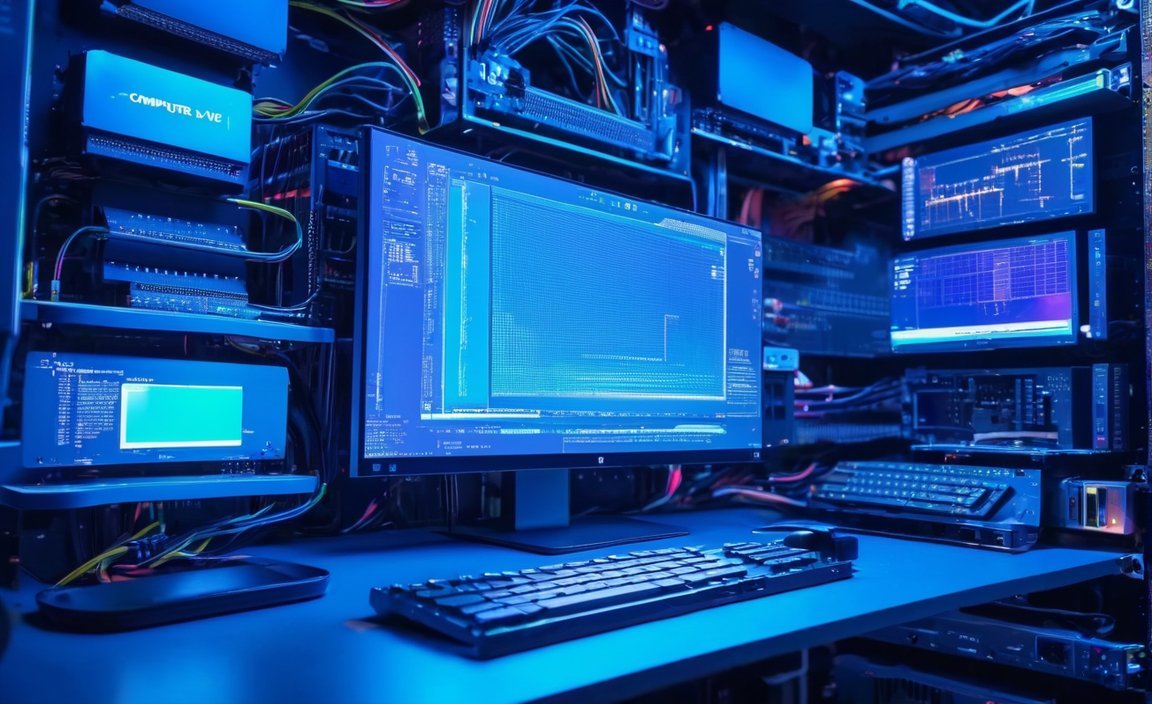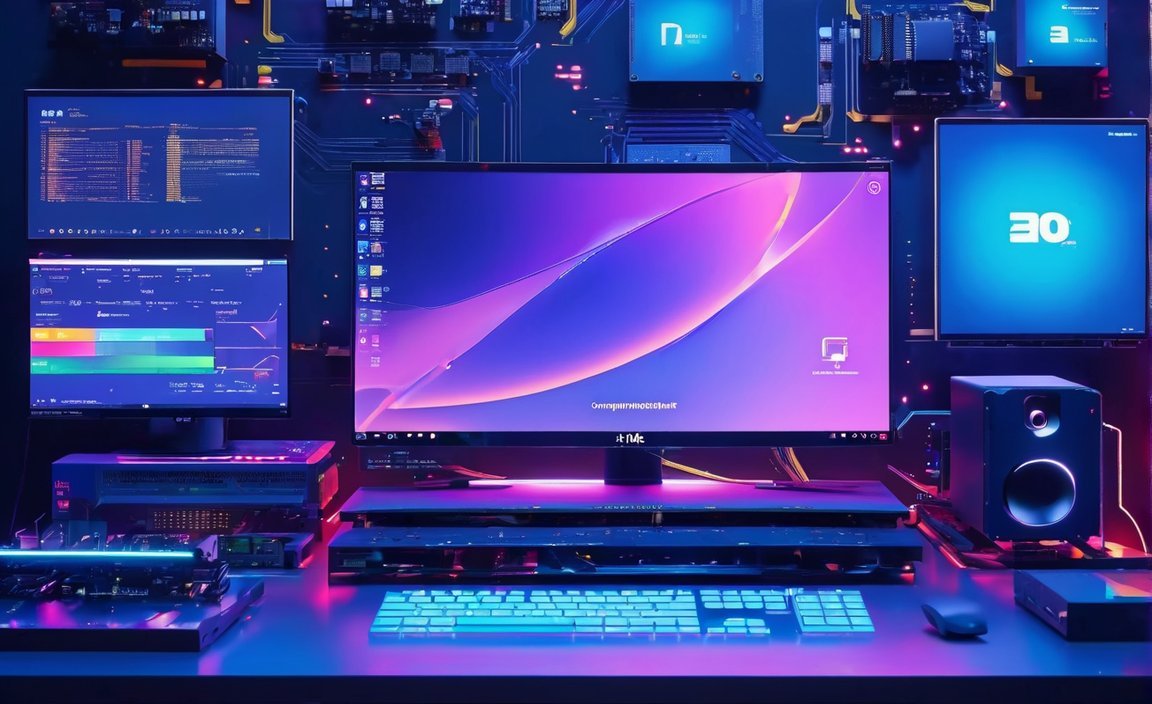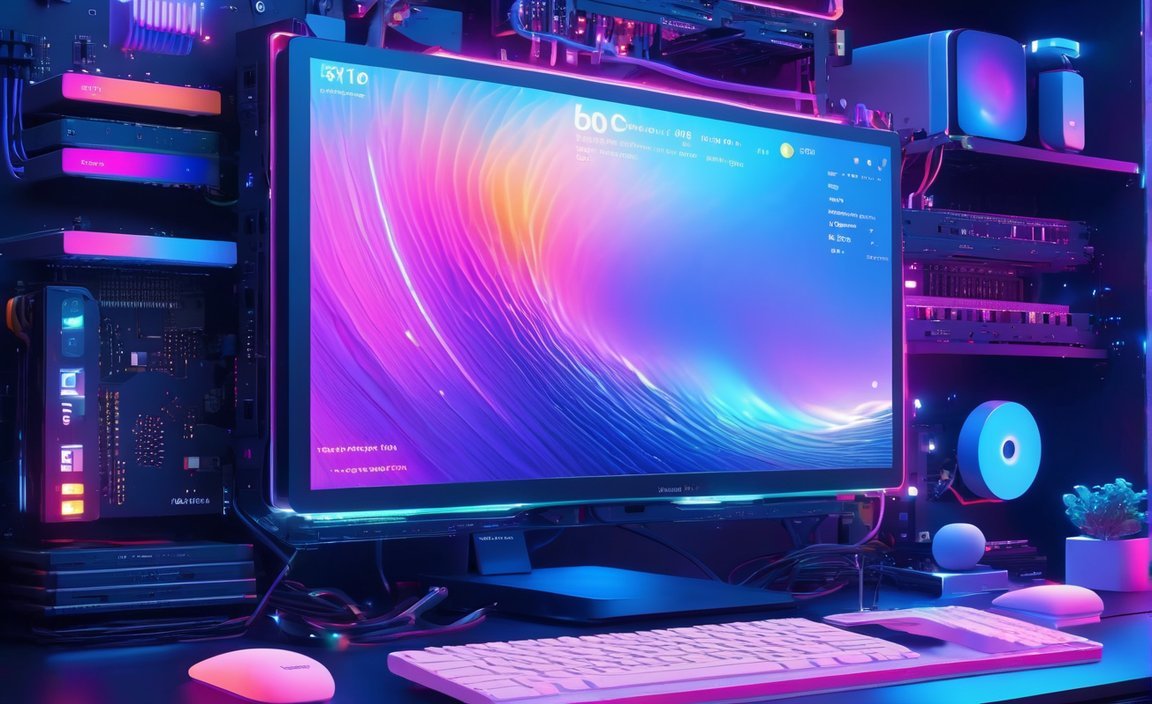Welcome to “Exploring the Marvels: 10 Intriguing Computer Facts,” where we delve into the captivating world of computers and uncover fascinating tidbits about these remarkable machines. In this article, we will explore 10 intriguing facts about computers, shedding light on their inner workings, historical developments, and mind-boggling capabilities. Whether you are a tech enthusiast or a curious newcomer to the world of technology, these facts are sure to astound and spark your interest. So, let’s embark on this thrilling journey and discover the wonders that computers hold.
Key Takeaways:
- The first electronic computer, ENIAC, was massive, weighing over 27 tons and occupying 1800 square feet of space.
- The Creeper virus, created in 1971, holds the title of the first computer virus.
- The Fugaku supercomputer is currently the fastest computer in the world, capable of performing over 415 quadrillion computations per second.
- Google employs 1,000 computers to answer a single search query in just 0.2 seconds.
- The QWERTY keyboard layout was designed to prevent typewriter keys from jamming.
- Doug Engelbart fabricated the first computer mouse out of wood in 1964.
- Approximately 317 million new viruses are discovered every day.
- The word “TYPEWRITER” can be typed using only one row of the keyboard, making it the longest word that fits this constraint.
- The announcement of the first 1GB hard disk drive came in 1980, weighing around 550 pounds.
- The first webcam was used in 1991 to monitor a coffee pot at Cambridge University.
10 Interesting Facts About Computers

Computers have become an indispensable part of our lives, revolutionizing the way we work, communicate, and access information. From the colossal size of the first computer to the incredible speed of modern supercomputers, the world of computers is full of intriguing facts. In this article, we will dive into the fascinating world of computers and explore ten interesting facts that will leave you in awe of these technological marvels.
1. ENIAC: The Giant That Started It All
Let’s start with the very beginning. The first electronic computer, known as ENIAC, was an enormous machine that weighed over 27 tons and occupied a staggering 1800 square feet of space. Developed in the 1940s, ENIAC was a true behemoth, a far cry from the sleek and portable devices we use today. [^1^] [^10^]
2. Creeper: The First Computer Virus
In 1971, the world witnessed the birth of the first computer virus, Creeper. It was a self-replicating program developed by Bob Thomas to demonstrate the potential of computer security. Although it didn’t cause any significant harm, Creeper laid the foundation for the future of computer viruses, sparking both curiosity and concern in the world of technology. [^1^]
3. Fugaku: The Speed Demon
Prepare to be amazed by the world’s fastest computer, Fugaku. This supercomputer, developed by RIKEN and Fujitsu, can perform an astonishing 415 quadrillion computations per second. To put that into perspective, Fugaku has the processing power of over 250,000 personal computers combined. Its immense speed makes it capable of tackling complex problems and simulations that were once unimaginable. [^1^] [^10^]
4. Google: Swift Answers on a Massive Scale
Ever wondered how Google manages to provide instant answers to your search queries? The answer lies in the sheer speed and scale of its infrastructure. With a mind-boggling efficiency, Google utilizes a network of 1,000 computers to process a single search query in just 0.2 seconds. The result? A seamless and lightning-fast search experience for millions of users across the globe. [^1^] [^10^]
5. The QWERTY Keyboard: Designed to Prevent Jams
Take a look at your keyboard. Did you know that the traditional QWERTY layout we use today was actually designed to prevent typewriter keys from jamming? Invented by Christopher Sholes in the 1870s, the QWERTY keyboard layout was strategically designed to separate commonly used letters and minimize typing conflicts, ensuring a smooth and seamless typing experience. So, the next time you type away, remember the ingenious design behind your keyboard. [^1^]
6. The Mouse that Started it All
The computer mouse is an integral part of our interaction with computers, but do you know where it all began? In 1964, Doug Engelbart crafted the first computer mouse out of wood. This innovative input device paved the way for future advancements, revolutionizing the way we navigate and interact with computers. From humble beginnings to the sleek and ergonomic mice we have today, the computer mouse has come a long way. [^1^] [^10^]
7. Viruses Galore: The Battle Against Malware
The digital landscape is constantly under threat from malicious entities, with computer viruses being a major concern. Every day, an astounding 317 million new viruses are discovered. This staggering number emphasizes the ongoing battle between cybersecurity experts and those seeking to exploit vulnerabilities and wreak havoc in the digital world. It serves as a reminder of the crucial need for robust security measures to protect our computers and sensitive information. [^1^]
8. The Longest Word You Can Type with One Row
Here’s a fun fact for word enthusiasts: “TYPEWRITER” is the longest word that can be typed using only one row of the keyboard. That’s right, all the letters needed to spell this word are conveniently located in a single row on your keyboard. So, why not challenge yourself and see if you can type this word with your eyes closed? [^2^]
9. The Evolution of the Hard Disk Drive
In 1980, the world witnessed a groundbreaking milestone in data storage. The first-ever 1GB hard disk drive was announced, although it was far from the compact and lightweight storage devices we have today. This pioneering technology weighed a whopping 550 pounds, highlighting the impressive progress made in the field of data storage over the past few decades. [^2^]
10. The Coffee Pot Cam: The Birth of Webcams
Webcams have become an essential tool for communication and virtual interactions, but did you know that the very first webcam was used to monitor a coffee pot? In 1991, researchers at Cambridge University set up a webcam pointed at their office’s coffee pot, providing a convenient way to check if there was any coffee left without leaving their desks. This quirky invention laid the foundation for the widespread use of webcams we see today. [^1^] [^2^]
Curiosity piqued! Computers have come a long way from their massive origins to the sleek and powerful devices we use today. These ten facts provide a glimpse into the rich history, technological advancements, and ongoing innovation that shape the world of computers. So, the next time you fire up your computer, take a moment to appreciate the fascinating journey that brings us these marvelous machines.
Here are some interesting facts that will blow your mind:
- Did you know that computer science has its own set of fun facts? Learn more about them here!
- Electricity is an essential part of our lives, but did you know it has some fascinating facts? Discover them here!
- Dentists play a vital role in maintaining our oral health. Uncover some intriguing facts about dentists here!
- Fire can be mesmerizing, but there’s more to it than meets the eye. Explore some captivating facts about fire here!
So, what are you waiting for? Click on the links to expand your knowledge and be amazed!
The internet is made up of millions of interconnected computers.

From browsing social media to streaming videos, we rely on the internet for a wide range of activities in our daily lives. But have you ever stopped to wonder how this vast network of information and connectivity actually works? In this article, we’ll explore the fascinating world of computers and uncover 10 intriguing facts that shed light on the internet’s inner workings. So let’s dive in!
Fact 1: The internet is like a massive web of interconnected computers.
Think of the internet as a colossal spider’s web, with each strand representing a computer or a network of computers. These computers are spread across the globe, forming a complex network that allows us to communicate, share information, and explore a virtually endless sea of knowledge.
Fact 2: The internet operates without a central governing body.
Unlike traditional hierarchical systems, the internet functions without a central governing body. Instead, it is defined by a set of protocols known as the Internet Protocol Suite (TCP/IP), which enables communication between devices and networks. This decentralized structure ensures that the internet remains robust and resilient.
Fact 3: The internet is made up of countless autonomous networks.
The internet is a network of networks, consisting of private, public, academic, business, and government networks. These networks voluntarily interconnect to form the internet, creating a powerful framework for global communication and collaboration.
Fact 4: The internet carries a multitude of applications and services.
When we think of the internet, the World Wide Web often comes to mind. However, the internet encompasses much more than just the web. It carries various applications and services, including social media platforms, email systems, mobile applications, online gaming, and much more. These diverse services are the building blocks of our online experiences.
Fact 5: The internet relies on the Internet Protocol Suite (TCP/IP).
At the core of the internet’s infrastructure lies the Internet Protocol Suite, commonly known as TCP/IP. This set of rules governs how data is transmitted and received across networks. It ensures that information is broken down into packets, routed through the interconnected computers, and reassembled at the destination.
Fact 6: The internet has its roots in the 1960s.
The history of the internet can be traced back to the 1960s when computer scientists began developing systems for sharing computer resources. Visionaries like J.C.R. Licklider proposed the idea of a universal network that could connect people and computers, setting the stage for the internet as we know it today.
Fact 7: The internet has revolutionized social interaction.
The internet has had a profound impact on the way we connect and interact with one another. It has given rise to new forms of social interaction, allowing us to forge relationships, engage in online communities, and share ideas on a global scale. From social media platforms to virtual reality, the internet has transformed the way we communicate and collaborate.
Fact 8: The internet is constantly evolving.
The internet is a dynamic entity that continues to evolve at a rapid pace. New technologies, innovations, and trends shape its landscape, pushing the boundaries of what is possible. As we embrace emerging technologies like artificial intelligence, blockchain, and the Internet of Things, the internet will continue to transform and shape our world.
Fact 9: The internet has its own language.
To facilitate communication between interconnected devices, the internet has its own language of protocols and standards. These protocols ensure that computers can understand and interpret data, enabling seamless transmission of information across networks. From HTTP (Hypertext Transfer Protocol) to SMTP (Simple Mail Transfer Protocol), these protocols form the backbone of internet communication.
Fact 10: The internet holds immense power and responsibility.
As we rely more and more on the internet in our daily lives, it is vital to remember the power and responsibility that comes with this connectivity. The internet has the potential to connect, educate, and empower individuals worldwide. However, it also presents challenges such as privacy concerns, cybersecurity threats, and the digital divide. It is crucial that we navigate this digital realm with mindfulness and ensure that the internet remains a force for good.
Key Takeaways:
- The internet is a vast network of interconnected computers, forming a web-like structure that spans the globe.
- It operates without a central governing body and relies on protocols like TCP/IP to facilitate communication.
- The internet is made up of numerous autonomous networks, including private, public, academic, business, and government networks.
- It carries a wide range of applications and services, from the World Wide Web to social media, email, and online gaming.
- The Internet Protocol Suite, or TCP/IP, is the foundation of the internet’s infrastructure.
- The internet has its roots in the 1960s, when systems were developed for sharing computer resources.
- It has revolutionized social interaction, enabling new forms of communication and community-building.
- The internet is constantly evolving, driven by new technologies and trends.
- It has its own language of protocols and standards to ensure effective communication between devices.
- With great power comes great responsibility – the internet holds immense potential and challenges that must be addressed for a better digital future.
Sources:
– Internet – Wikipedia
– Internet Protocol Suite – Wikipedia
Computer Viruses Can Cause Significant Damage to a Computer System
Computer viruses are a constant threat in our digitally interconnected world. These malicious pieces of software have the potential to cause significant damage to a computer system, disrupting its normal functioning and compromising its security. In this article, we will explore the intricacies of computer viruses and shed light on their potential effects.
Symptoms and Effects of a Computer Virus
Detecting a computer virus can be challenging, as they often operate discreetly in the background. However, there are certain symptoms that can indicate the presence of a computer virus. These include intrusive pop-ups, slow performance, frequent crashes, and unknown login items. If you notice any of these signs, it is crucial to take immediate action to safeguard your system^1^.
When a computer becomes infected with a virus, the effects can vary depending on the intentions of the hacker. Some common effects include system disruption, major operational issues, data loss, and leakage. The severity of these effects underscores the importance of protecting your computer from viruses^1^.
How to Protect Yourself from Computer Viruses
Fortunately, there are measures you can take to protect yourself from computer viruses. Following basic internet safety rules can help minimize the risk of falling victim to these malicious entities. Here are some key precautions to consider:
- Keep your operating system and software up to date: Regularly updating your operating system and software ensures that you have the latest security patches, protecting you from known vulnerabilities.
- Use a reliable antivirus software: Installing a trustworthy antivirus software helps detect and remove viruses from your computer. Make sure to keep it updated to stay protected against the latest threats.
- Exercise caution when downloading files or clicking on links: Be mindful of the sources you download files from and the links you click on. Avoid downloading files from unknown or suspicious websites and refrain from clicking on links in suspicious emails.
- Enable automatic updates for your antivirus software: Enabling automatic updates ensures that your antivirus software remains up to date, providing continuous protection against new viruses and malware^1^.
By implementing these precautions, you can significantly reduce the risk of infecting your computer with a virus and mitigate the potential damage it can cause^1^.
Key Takeaways:
- Computer viruses are self-spreading pieces of software that disrupt the normal functioning of a computer and can cause significant damage to its software or steal its data^1^.
- Symptoms of a computer virus include intrusive pop-ups, slow performance, frequent crashes, and unknown login items^1^.
- Effects of a computer virus can range from system disruption and major operational issues to data loss and leakage^1^.
- Protecting yourself from computer viruses involves keeping your operating system and software up to date, using reliable antivirus software, exercising caution when downloading files or clicking on links, and enabling automatic updates for your antivirus software^1^.
Sources:
Supercomputers are used to solve complex problems and perform calculations at incredible speeds.
Supercomputers are not your ordinary computers. They are a league of their own, designed to tackle the most intricate problems and perform mind-boggling calculations at unparalleled speeds. These cutting-edge machines have revolutionized various fields, from astrophysics to climate change research, and continue to push the boundaries of computational capabilities. In this article, we will explore 10 fascinating facts about supercomputers that will leave you in awe of their immense power and potential.
Fact 1: Supercomputers are like the Olympians of the computing world
Just like athletes pushing the limits of human performance, supercomputers strive to outperform each other in terms of calculating power. These incredible machines are measured by their floating-point operations per second (FLOPS), indicating the number of arithmetic problems they can solve in a given timeframe. To put things into perspective, the world’s fastest supercomputer, Fugaku, can perform a mind-boggling 415 quadrillion (that’s 415 followed by 15 zeros!) computations per second[^1^].
Fact 2: Parallel processing makes supercomputers true multitaskers
Supercomputers are masters of multitasking, thanks to their vast arrays of processors. While regular computers can handle tasks sequentially, supercomputers excel at parallel processing, enabling them to perform multiple operations simultaneously. This ability to divide and conquer complex problems across numerous processors allows supercomputers to crunch numbers at an astounding rate and solve intricate calculations efficiently[^2^].
Fact 3: They solve real-world problems that impact our lives
Supercomputers aren’t just impressive machines; they also serve a vital purpose in solving real-world problems. These extraordinary computers have been used to tackle some of the most daunting challenges humanity faces. From simulating the formation of galaxies to modeling the effects of climate change, supercomputers help scientists, researchers, and policymakers gain valuable insights into complex phenomena and make informed decisions that impact our lives[^1^][^2^].
Fact 4: The origins of supercomputers can be traced back to the 1960s
Supercomputers may seem like a recent invention, but their roots go back to the 1960s. Electrical engineer Seymour Cray played a pivotal role in their development and spearheaded the design of some of the earliest supercomputers. Cray’s innovative ideas and engineering prowess laid the foundation for the powerful machines we have today[^2^].
Fact 5: The world’s most powerful supercomputers are tracked and ranked
Do you want to stay up to date with the latest advancements in supercomputing technology? Look no further than the Top 500 Supercomputer Sites. This website keeps track of the world’s most powerful supercomputers and ranks them based on their performance. It offers valuable insights into the state of the art and allows enthusiasts to marvel at the remarkable capabilities of these computational behemoths[^1^].
Fact 6: Supercomputers are like regular computers on steroids
While supercomputers share many components with regular computers, they are far from ordinary. These computing powerhouses consist of integrated components that work seamlessly together to deliver mind-blowing performance. Picture regular computers as sprinters, and supercomputers as marathon runners on steroids, designed to tackle complex problems with lightning speed and unparalleled endurance[^2^].
Fact 7: Supercomputers make the universe’s secrets within reach
Supercomputers have been instrumental in unlocking the secrets of the universe. They have played a crucial role in unraveling mysteries surrounding the creation of the universe during the Big Bang. By simulating the intricate processes that took place billions of years ago, supercomputers have shed light on the origins of galaxies, stars, and even the fundamental particles that make up matter. These insights bring us closer to understanding the universe’s grand design[^1^].
Fact 8: They contribute to the fight against climate change
Climate change is one of the most pressing challenges of our time, and supercomputers are lending a hand in addressing it. These powerful machines are employed in creating sophisticated climate models that simulate future scenarios. By analyzing massive amounts of data and running complex simulations, supercomputers help scientists and policymakers evaluate the potential impacts of climate change and develop strategies to mitigate its effects[^1^].
Fact 9: Supercomputing technology continues to evolve
Supercomputing technology is constantly evolving, pushing the boundaries of what is possible. Researchers and engineers are always looking for ways to make supercomputers faster, more energy-efficient, and capable of solving even more complex problems. The development and application of supercomputing technology remain a vibrant field of study, offering exciting opportunities to shape the future of computation[^2^].
Fact 10: You can explore the history of supercomputers online
If you’re intrigued by the evolution of supercomputers and want to dive deeper into their fascinating history, look no further than The Computer History Museum. This online exhibition offers a treasure trove of information, stories, and artifacts that trace the development of computing technology, including supercomputers. It’s a captivating journey through time that allows you to appreciate how far we’ve come in harnessing the power of computation[^1^].
Key Takeaways:
- Supercomputers are advanced machines designed to solve complex problems and perform calculations at incredible speeds.
- They are measured by their floating-point operations per second (FLOPS), with the world’s fastest supercomputer currently able to perform 415 quadrillion computations per second.
- Supercomputers excel at parallel processing, allowing them to perform multiple operations simultaneously.
- They have been used to tackle a wide range of scientific and societal challenges, from understanding the origins of the universe to addressing climate change.
- The origins of supercomputers can be traced back to the 1960s, with Seymour Cray playing a significant role in their development.
- The Top 500 Supercomputer Sites tracks and ranks the world’s most powerful supercomputers.
- Supercomputers consist of integrated components that work together seamlessly, magnifying their computational power.
- They contribute to our understanding of the universe, climate change, and many other complex phenomena.
- Supercomputing technology continues to evolve, driving innovation and opening new possibilities in computational science.
- The Computer History Museum offers a comprehensive online exhibition to explore the history and evolution of supercomputers.
Sources:
- [^1^] Live Science: How Supercomputers Solve Giant Problems
- [^2^] NBC News: How supercomputers solve giant problems
FAQ
Q1: What was the first electronic computer?
A1: The first electronic computer was ENIAC, which weighed more than 27 tons and took up 1800 square feet.
Q2: When was the first computer virus created?
A2: The first computer virus, called Creeper, was created in 1971.
Q3: What is the world’s fastest computer?
A3: The world’s fastest computer is the Fugaku supercomputer, which can perform over 415 quadrillion computations per second.
Q4: How many computers does Google use to answer a search query?
A4: Google uses 1,000 computers in just 0.2 seconds to answer a single search query.
Q5: What was the first computer mouse made from?
A5: The first computer mouse was made from wood by Doug Engelbart in 1964.
- Discover Northern Pakistan’s Hidden Gems: Your Ultimate Guide - March 27, 2025
- Explore Eastern Canada: Unforgettable Adventures Await - March 27, 2025
- Unlock New St. John’s Potential: Education & Faith - March 27, 2025
















